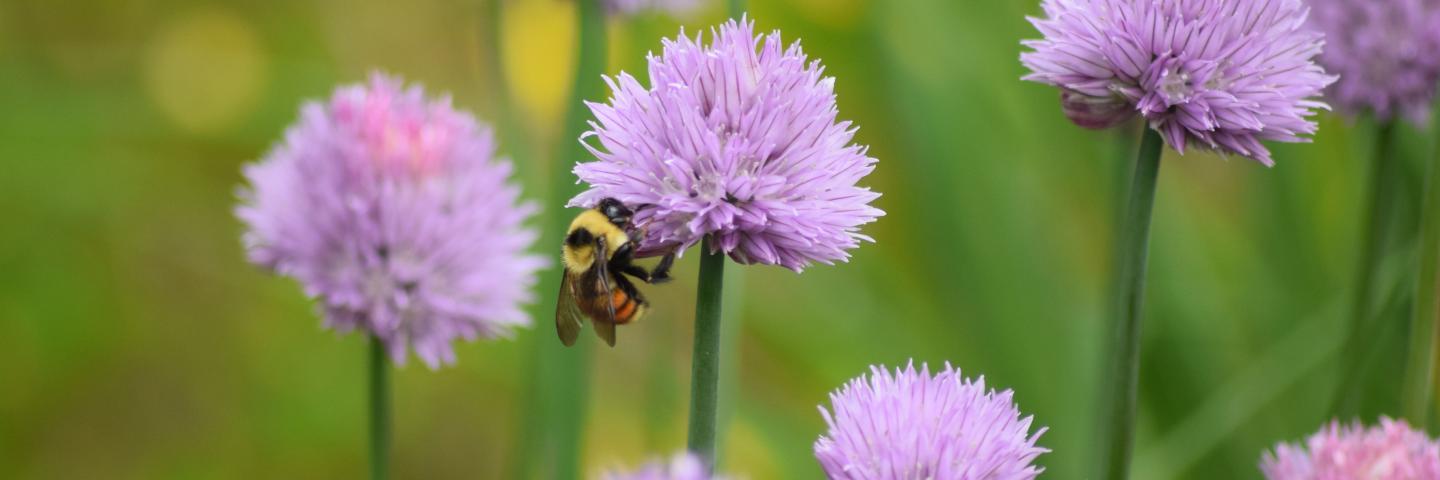
Protecting producers and pollinators across six New England states.
The New England Pollinator Partnership (NEPP) is an agreement between the USDA's Natural Resources Conservation Service (NRCS), the U.S. Fish and Wildlife Service (USFWS), and participating landowners to help restore populations of the rusty patched bumble bee, monarch butterfly, and nine other bumble bee species found throughout New England.
This partnership aims to increase pollinator habitat, reduce pesticide exposure to pollinators, and provide assurances to participating landowners. Assurances provide a "peace-of-mind" that if the monarch butterfly or other target species are federally listed and harmed while carrying out pollinator conservation activities, the landowner is not liable for incidental "take" under the Endangered Species Act. Endangered Species Act protections are offered for the entire 25-year lifespan of this Agreement (April 30, 2044).
Participating landowners stand to benefit from increased abundance and diversity of crop pollinators and natural enemies (insects that help control crop pests).
Importance of the covered species under the NEPP
The pollinators covered under NEPP are important to overall ecology, crop production and native plant reproduction. Many have, are currently, or are likely to begin facing declines due to a variety of synergistic factors. These include habitat loss or fragmentation, pesticide exposure, pathogens, loss of genetic diversity, resource competition, and climate change. See information on each of the covered species below.
Covered Species
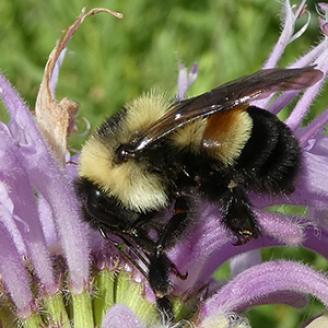
Rusty Patched Bumble Bee
(Bombus affinis) - Federally Endangered
Photo courtesy Eric Venturini (Xerces)
The rusty-patched bumble bee, like most bumble bees, lives in colonies. Only the mated queen overwinters and emerges in early spring, requiring immediate nectar and pollen resources in order to build up the colony throughout the season. This bee species has a relatively long life cycle, which results in the species requiring sufficient floral blooms available from April to September. Although this species requires a long season of blooms, it is a generalist when it comes to the floral plant species that can provide the food resources they need. However, there are certain native flowering plants that are considered “superfood” plants for bumble bees, including some specific to the rusty patched bumble bee. These include plants such as Wild bergamont (Monarda fitulosa), hyssop (Agastache spp.), goldenrod (Solidago spp.), joe pye weed (Eutrochium spp.), coneflowers (Echinacea sppe.), native thistles (Cirsium spp.), asters (Symphyotrichum spp.), jewelweed (Impatiens capensis), mountain mint (Pycanthemum spp.), meadowsweet (Spirea spp.), or wild cranberry (Vaccinum spp.).
See more information from the IUCN red list and USFWS.
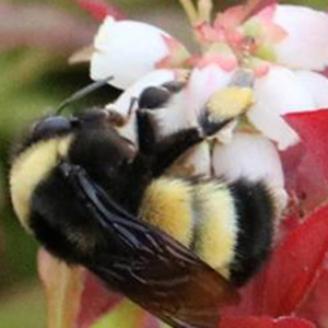
Yellow Banded Bumble Bee
(Bombus terricola) - Not Warranted for listing
Photo courtesy Sarah Foltz Jordan (Xerces)
Although the species was determined not warranted for listing under the ESA by the USFWS in 2019, yellow banded bumble bee populations experienced major declines in its abundance across its range. The USFWS determined this did not warrant listing because the species still maintains lower population levels throughout the range. This species that is on the decline is also a host species to socially parasitic bumble bees that have also seen population declines.
See more information from the IUCN red list.
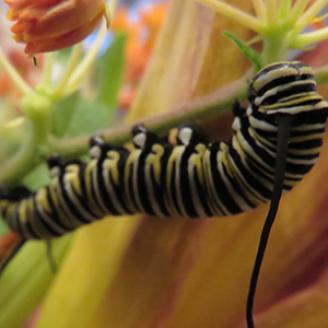
Monarch Butterfly
(Danaus plexippus) - Candidate species under Review by USFWS
Photo courtesy Eric Venturini (Xerces)
The Monarch butterfly is a widespread species across the United States, but it has faced recent declines, and it is being reviewed by the USFWS as a candidate for listing. It is a unique species that's eastern U.S. populations migrate from Mexico up to New England each year. This butterfly species requires milkweed plants in the genus Asclepias, which is the obligate host plant that monarch caterpillars feed on. In the adult stage, monarchs require a variety of nectar host plants to feed on to support the monarch's dietary needs throughout the breeding and migration season. The species is present in New England from summer to fall, so milkweed and other nectar sources are needed late into the growing season.
See more information from the IUCN red list.
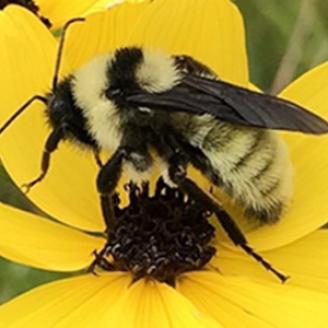
Ashton's Cuckoo Bumble Bee
(Bombus bohemicus)
Photo courtesy Bryan Smith
Ashton's cuckoo bumble bee is a social parasite that relies on its host species to reproduce. The hosts for this species include the rusty-patched bumble bee and the yellow-banded bumble bee, which are in decline. In 2017 a population of Ashton’s cuckoo bumble bee was discovered in northern Aroostook County, Maine.
See more information from the IUCN red list.
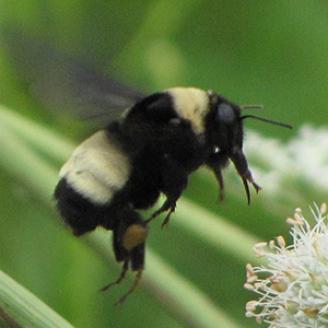
American Bumble Bee
(Bombus pensylvanicus)
Photo courtesy Jennifer Hopwood (Xerces)
The American bumble bee is not being considered for listing by the USFWS, but it was once very widespread and has faced major declines like many other bumble bee species. It is a long-tongued bumble bee, allowing it to feed on deeper flowers.
See more information from the IUCN red list.
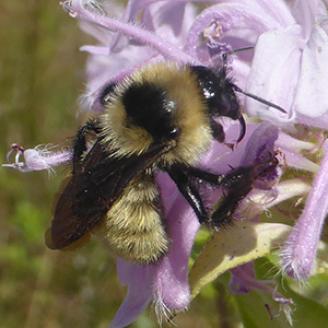
Yellow Bumble Bee
(Bombus fervidus)
Photo courtesy Sarah Foltz Jordan (Xerces)
The Yellow bumble bee is facing declines in its population. It is a long tongued and later emerging species, allowing it to feed on and pollinate deep late-blooming flowers.
See more information from the IUCN red list.
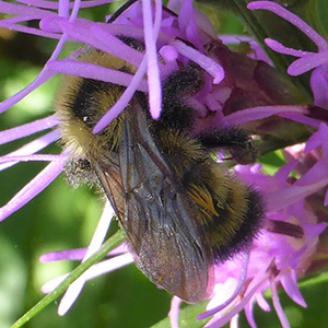
Lemon Cuckoo Bumble Bee
(Bombus citrinus)
Photo courtesy Sarah Foltz Jordan (Xerces)
Lemon cuckoo bumble bee is not currently in decline, but it faces the same threats that are causing declines in many other bumble bee species. It is also a social parasite that relies on other bumble bee species to reproduce.
See more information from the IUCN red list.
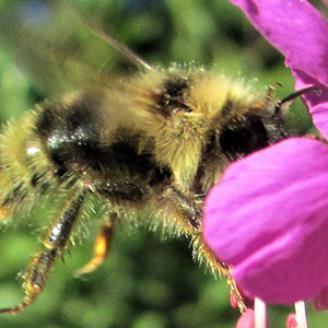
Fernald Cuckoo Bumble Bee
(Bombus flavidus)
Photo courtesy Lynn Bush
Fernald cuckoo bumble bee is not currently facing any serious declines, but it faces the same threats that are causing declines in many other bumble bee species. It is also a social parasite that relies on other bumble bee species to reproduce.
See more information from the IUCN red list.
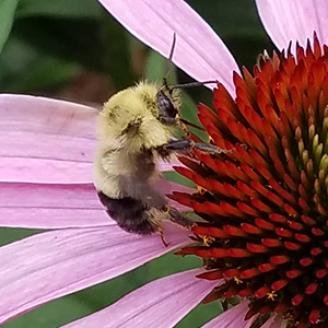
Confusing Bumble Bee
(Bombus perplexus)
Photo courtesy Kelly Gill (Xerces)
Confusing bumble bee is currently stable in population size, but it faces the same threats that are causing declines in many other bumble bee species. It is a known host to the Fernald cuckoo bumble bee.
See more information from the IUCN red list.
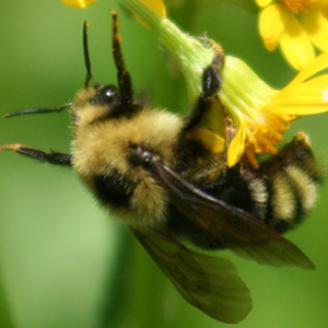
Indiscriminate Cuckoo Bumble Bee
(Bombus insularis)
Photo courtesy Mike Akresh
Indiscriminate cuckoo bumble bee is facing low level declines in its population, but it is a social parasite that is known to rely on the declining yellow banded bumble bee.
See more information from the IUCN red list.
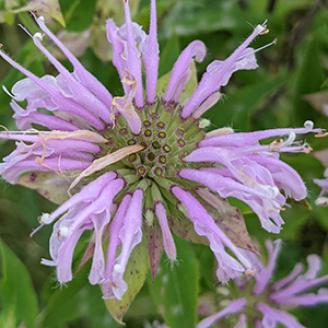
Variable Cuckoo Bumble Bee
(Bombus variabilis)
Placeholder photo of bee balm (Monarada fistulosa) courtesy Erin Cocca (Xerces)
Variable cuckoo bumble bee was a widespread bee, but it is extremely rare and facing large scale declines. The only known host for this species is the American bumble bee that has faced major declines.
See more information from the IUCN red list.
Importance of NEPP for pollinators
Providing floral habitat
Pollinating insects need nectar and pollen food sources to be able to live, reproduce, and maintain populations. High quality habitats, like those created using the NRCS practice Wildlife Habitat Planting (420), provide a diversity of native perennial wildflowers that offer a variety of nectar and pollen resources throughout the entire growing season.
Providing floral resources throughout the entire season is very important for providing habitat to a variety of species that may be active at different times and for species like the rusty-patched bumble bee that has a long lifecycle and is active from April-September. The presence of high-quality insect habitat throughout the landscape provides other benefits, such as ecological pest control, increased food for other wildlife, and increased carbon sequestration.
Providing nesting and overwintering resources
Pollinators also require unique nesting and overwintering resources to complete their life cycles. Native bees will nest or overwinter in a variety of natural structures such as within old rodent burrows in the soil, leaf litter, downed logs, snag trees, rock walls, hollow stems, or under bunch grasses. It is important to ensure these resources are available nearby when creating habitat for native bees, so their travel distance from food resources to nesting and overwintering resources will not cause these animals to expend excessive energy. A simple action such as creating a snag tree or leaving leaf litter or bunch grasses throughout the winter in an edge area next to flowering habitat can create habitat with all of the necessary elements for a pollinator to live, reproduce, and carry-on to the next generation. The NRCS practice Structures for Wildlife (649) can support landowners in the creation of many of these important resources.
Providing protection from management activities
Providing high quality habitat that is safe from pesticide exposure or other disturbance is also critical for conserving these covered species and all pollinator species. Management actions such as mowing can completely change the value of pollinator habitat by removing flowers during the active bee season. Pesticide use can also have potential effects to the value of habitat if herbicides are able to drift into habitat areas, harming floral resources. Pesticides like insecticide or fungicide can also create negative effects for exposed insects.
Other simple ways to reduce harm to pollinators and their habitat include adjusting mowing schedules (timing and frequency) to avoid mowing areas with milkweed when monarch caterpillars are present on the milkweed host plants and mowing in the dormant season after plants are done blooming and pollinators are not active. NRCS practices like Pest Management Conservation System (595), Early Successional Habitat Development/Management (647), or Upland Wildlife Habitat Management (645) can help land managers create management plans that reduce harm to pollinators.
How to participate
Any landowner eligible for financial or technical assistance from NRCS in New England can participate. Participants must:
- Work with NRCS to develop a conservation plan.
- Implement at least one core conservation practice (shown above).
- Adhere to NEPP Best Management Practices, like maintaining a no-spray pesticide buffer around established pollinator habitat.
Core Practices
Participating landowners must implement at least one of the following Core NRCS Environmental Quality Incentives Program (EQIP) practices to participate in the New England Pollinator Partnership:
- Brush Management (314)
- Herbicide Weed Treatment (315)
- Conservation Cover (327)
- Field Border (386)
- Riparian Forest Buffer (391)
- Wildlife Habitat Planting (420)
- Hedgerow Planting (422)
- Pest Management Conservation System (595)
- Tree/Shrub Establishment (612)
- Upland Wildlife Habitat Management (645)
- Early Successional Habitat Development/Management (647)
- Wetland Restoration (657)
What do landowners get?
If interested, participating landowners can receive regulatory assurances. In other words, if a rusty patched bumble bee is injured or killed, or its habitat degraded significantly, and the injury, death, or degraded habitat is the result of activities carried out in accordance with BMPs and NRCS conservation practice standards, the landowner is protected from liability for that “take." Further, if any pollinator species covered by this agreement are listed in the future as Federally threatened or endangered, participating landowners will receive the same liability protection for the newly listed species.
Participating landowners will also see an increase in the number of native pollinators that pollinate crops and forage on newly established habitat.
For more information on bumble bee conservation, visit this site from The Xerces Society.
For more information on Monarch butterfly conservation, visit this site from The Xerces Society.
To become a participating producer, contact your local NRCS Field Office.
For general information, or to learn how to support this partnership in other ways, contact: NRCS-Maine State Biologist Jeremy Markuson or Pollinator Conservation Specialist and NRCS-Maine Partner Biologist Erin Cocca.
Additional Information
Apply for Environmental Quality Incentives Program (EQIP)
The Environmental Quality Incentives Program (EQIP) provides financial and technical assistance to agricultural producers and non-industrial forest managers.
Learn MoreHistorically Underserved Farmers and Ranchers
The Agriculture Improvement Act of 2018 (2018 Farm Bill) includes provisions that address the unique circumstances and concerns of socially disadvantaged, beginning, limited resource, and veteran farmers and ranchers (“historically underserved producers”).
Learn MoreFarm Bill
The 2018 Farm Bill was enacted on December 20, 2018. The Farm Bill continues its strong support for conservation efforts of America’s farmers and ranchers through reauthorization and expanded flexibility of NRCS conservation programs.
Learn MoreReady to get started?
Contact your local service center to start your application.
How to Get Assistance
Do you farm or ranch and want to make improvements to the land that you own or lease?
Natural Resources Conservation Service offers technical and financial assistance to help farmers, ranchers and forest landowners.

To get started with NRCS, we recommend you stop by your local NRCS field office. We’ll discuss your vision for your land.
NRCS provides landowners with free technical assistance, or advice, for their land. Common technical assistance includes: resource assessment, practice design and resource monitoring. Your conservation planner will help you determine if financial assistance is right for you.
We’ll walk you through the application process. To get started on applying for financial assistance, we’ll work with you:
- To fill out an AD 1026, which ensures a conservation plan is in place before lands with highly erodible soils are farmed. It also ensures that identified wetland areas are protected.
- To meet other eligibility certifications.
Once complete, we’ll work with you on the application, or CPA 1200.
Applications for most programs are accepted on a continuous basis, but they’re considered for funding in different ranking periods. Be sure to ask your local NRCS district conservationist about the deadline for the ranking period to ensure you turn in your application in time.
As part of the application process, we’ll check to see if you are eligible. To do this, you’ll need to bring:
- An official tax ID (Social Security number or an employer ID)
- A property deed or lease agreement to show you have control of the property; and
- A farm number.
If you don’t have a farm number, you can get one from USDA’s Farm Service Agency. Typically, the local FSA office is located in the same building as the local NRCS office. You only need a farm number if you’re interested in financial assistance.
NRCS will take a look at the applications and rank them according to local resource concerns, the amount of conservation benefits the work will provide and the needs of applicants. View Application Ranking Dates by State.
If you’re selected, you can choose whether to sign the contract for the work to be done.
Once you sign the contract, you’ll be provided standards and specifications for completing the practice or practices, and then you will have a specified amount of time to implement. Once the work is implemented and inspected, you’ll be paid the rate of compensation for the work if it meets NRCS standards and specifications.

